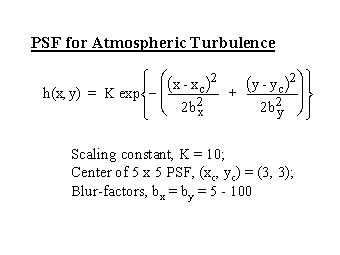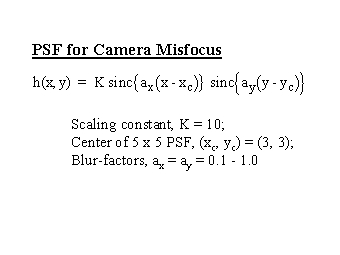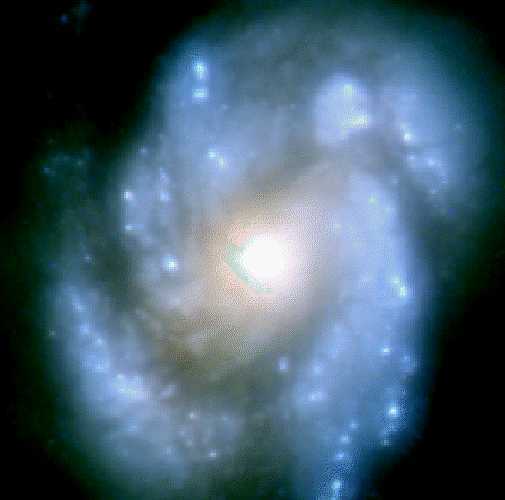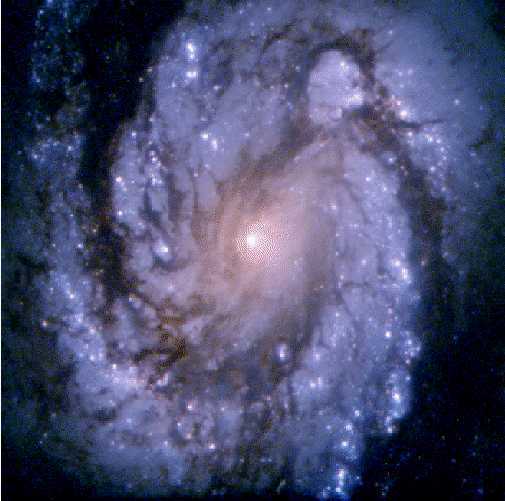Digital Image Processing
Course Nos. ECE.09.452/ECE.09.552
Fall 2009
Laboratory Project 3: Degradation Models
and Digital Image Restoration
Due Monday, Nov 23
Objective
The objective of this project is to study the effects of image
degradations (in particular, blurring) and implement appropriate
restoration techniques. This project has three parts. In Part 1, you
will implement degradation and
restoration techniques on a simulated image. In Part 2, you will
attempt
to replicate the degradation and restoration models illustrated in the
textbook.
In Part 3, you will attempt to restore a degraded image, given some
information
about the nature of the degradation and/or the original image
characteristics.
Note: Display all images using a 256 gray-level map.
Part 1
In this part, you will investigate blurring and restoration techniques
using
a simple simulated image.
Part 2
In this part, you will replicate the blurring and restoration
techniques
illustrated in the textbook on pages 260-265.
Part 2 (a): Atmospheric turbulence model and restoration using
inverse
and Wiener filters
- Download the aerial photography image shown in Figure 3 (same as
Figure
5.25(a) in the textbook). Degrade the image to produce the severe, mild
and
low atmospheric turbulence shown in Figures 5.25 (b) through (d) of the
textbook,
using the model given by Equation 5.6-3.
Figure 3: Aerial photography image (480 x 480 pixels) shown
in
Figure 5.25(a) in Gonzalez & Woods.
(LEFT
CLICK on image to get original)
- Attempt to restore the degraded images using inverse filters -
both
full and radially limited. Use a Butterworth model for the cut-off in
order
to minimize spatial ringing. Figure 5.27 in the textbook illustrates
typical
results.
- Attempt to restore the degraded images using Wiener filters.
Figure
5.28 in the textbook illustrates typical results.
Part 2 (b): Planar motion model and restoration using inverse and
Wiener
filters
- Download the textbook cover image shown in Figure 4 (same as
Figure 5.26(a) in the textbook). Using the model shown in Equation
5.6-11 of the
textbook, degrade the original image to the produce a set of 1-D and
2-D
planar motion blurred images. Use the same parameters as given in the
textbook
(a = b = 0.1 and T = 1).
- Also generate another set of images that include the effects of
additive
Gaussian noise (zero mean, variance of 650 pixels).
Part 3
In this part, you are presented with an actual image restoration
problem for which you will make hypotheses, discuss and implement
solution techniques.
Part 3 (a): Volumetric rendition of a human heart (Problem 5.20 in
Gonzalez
& Woods)
- The image shown in Figure 5 is a blurred, 2-D projection of the
volumetric
rendition of a heart. It is known that each of the cross-hairs on the
right,
bottom part of the image was 3 pixels wide, 30 pixels long, and had
gray
level values of 255 before blurring.
Figure 5: Volumetric rendition of a human heart (623 x 563
pixels)
shown in Problem 5.20 in Gonzalez & Woods.
(LEFTCLICK on image to get original)
- Given this information, using a step-by-step procedure, determine
the
blurring function H(u,v).
- Implement appropriate digital image restoration techniques on
this
blurred image.
Part 3 (b): Spherical aberration in the Hubble Space Telescope
prior
to servicing
The first picture shown in Figure 6 below is that of the Spiral Galaxy
M100, (in the constellation Coma Berenices), that was
obtained
by the Hubble Space Telescope in
November
1993.
This picture is degraded (blurred), in a large part, to the effects
of
"spherical aberration" in the Hubble's primary mirror. Spherical
aberration occurs when a spherical lens or mirror is improperly ground.
Light rays near
the edges of the lens/mirror are more strongly refracted/reflected and
come
to a focus nearer the lens/mirror than the rays closer to the axis.
Subsequently, a NASA space shuttle mission installed corrective
optics to compensate for the Hubble's blurred vision. The result of
this effort can
be seen in the second figure, which shows the same M100 galaxy,
obtained using
the modified telecope. This image is one of the first
post-servicing
images.
Could we have obtained similar results using the image restoration
techniques that were discussed in the class? What would be the effect
of using inverse/Wiener filtering techniques, assuming PSFs of the
forms used in parts 1 and 2 of this project? Demonstrate with examples.
Your report should be in the usual format.







